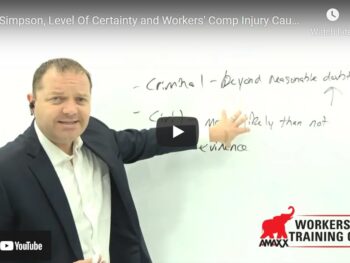Is your litigation rate higher than you’d like? Do you know why?
There are myriad reasons injured workers hire attorneys to defend them, but there is often one overarching theme: fear. By taking simple but highly effective steps, you can reduce the anxiety and significantly lower your litigation rate.
Why Hire Attorneys
Put yourself in the shoes of an injured worker, and you can begin to understand what they fear and how that drives them to hire attorneys. Say you’ve been in a particular job for several years, are doing well and suddenly you’re involved in an incident that renders you unable to work. And let’s supposed you like most people are unfamiliar with the specifics of the workers’ compensation system.
Now suppose you’ve been at home nursing your injury for a week. You’re in pain, the bills are piling up, your spouse is asking questions, and you haven’t yet heard from anyone connected with your employer or the workers’ compensation system. What would you do?
That scenario, in a nutshell, describes what far too many injured workers go through. Increasingly, they have fear:
- Fear they won’t have money to pay their bills.
- Fear they won’t have access to or money for proper medical care.
- Fear they will lose their jobs.
Click Link to Access Free PDF Download
“Avoid the 3 Primary Reasons Injured Workers’ Hire Attorneys”
While sitting at home seeing TV commercials for plaintiffs’ attorneys, many injured do what might be considered normal – they call a lawyer. This situation is typical, and yet avoidable in the workers’ compensation system.
Showing empathy, communicating, and providing information are the primary tools to prevent a worker in the above scenario from hiring a lawyer. Creating an atmosphere of trust before injuries will help lower your litigation rate even more.
Eliminate the Fear
Knowing the fears mentioned above can help you avoid them. Here are some simple steps:
- Communicate. Getting in touch with the injured worker as soon as possible after the injury is crucial. The message should convey that you value the employee and want him back on the job as soon as he is ready. You can do this in a variety of ways:
- Call. Just as you might call a worker who was out due to a non-work related injury, a brief phone call to inquire as to how the worker is doing shows you care about the person. You can also reassure the employee that his claim is going through the workers’ compensation process and let him know he will hear from those who are handling his claim.
- Send a card. If another worker sustains a severe injury while boating over the weekend and is out of work, you might send a get-well card, right? It should be the same for an injured worker. They also want to know their employer and coworkers are concerned and thinking about them, and – especially in the case of injured workers – that their jobs will be waiting for him upon their return. A simple, inexpensive card with good wishes can make a world of difference to someone in pain and afraid.
- Text. If it is a younger worker and someone who prefers texting to phone calls, send one. It can be short, ‘how are you doing today’ message.
- Email. A quick email sends the message that you are thinking about the worker. You might also include something about the company – some news or a funny incident that happened with the employee’s coworkers.
- Explain the System. Those of us in the industry know the complexity of workers’ compensation. Imagine you are an injured worker, thrust into the middle of this process you don’t understand – or trust. You’d need someone or something to explain it to you. There are a couple of ways to do this:
- Employee Brochure. A short, simple brochure should be given to all injured workers. It should tell them:
- What to expect. It should say, for example, that the visit to the emergency room and follow-up medical bills will be paid. It should also include information about the workers’ compensation system and when and how determinations are made as to whether a claim will be accepted. It should also include a brief section explaining the consequences of fraud. You want the injured worker to know you care about them, but that you won’t tolerate abuse.
- Who is in charge? Unless the company is self-insured, it should explain that the X company is the employer’s workers’ compensation insurer and that someone from that organization will contact the injured worker.
- When/how. It should explain how and when the worker will receive benefits.
- Perhaps most importantly, it should convey that you want the injured worker to return to the company as soon as possible, and provide information about light-duty work and other aspects of the employer’s return-to-work program.
- Create an Environment of Trust. Some organizations have a culture that discourages employees from reporting on-the-job injuries. There’s a message that doing so can hinder chances of a promotion or transfer, or may even result in firing. Ultimately, some injured worker in such a company will hire an attorney. Instead, you want to create an environment of transparency and trust. If your employees trust you, they are much less likely to engage attorneys when injured.
Talking openly about the workers’ compensation system is one way to do that; whether during safety meetings or through internal newsletters or emails. A brochure should be given to all employees to explain the workers’ compensation process and what to expect if injured, as well as provide information on how to report workplace injuries and illnesses.
Conclusion
Injured workers, like all of us, want to be treated with dignity and respect. Being injured and thrust into a system, they don’t understand people more vulnerable and insecure. By reaching out to them, showing empathy and explaining next steps, you create a trusting environment and can significantly reduce your litigation rate.

Author Michael Stack, CEO Amaxx LLC. He is an expert in workers compensation cost containment systems and helps employers reduce their work comp costs by 20% to 50%. He works as a consultant to large and mid-market clients, is co-author of Your Ultimate Guide To Mastering Workers Comp Costs, a comprehensive step-by-step manual of cost containment strategies based on hands-on field experience, and is founder & lead trainer of Amaxx Workers’ Comp Training Center. .
Contact: mstack@reduceyourworkerscomp.com.
Workers’ Comp Roundup Blog: https://blog.reduceyourworkerscomp.com/
©2017 Amaxx LLC. All rights reserved under International Copyright Law.
Do not use this information without independent verification. All state laws vary. You should consult with your insurance broker, attorney, or qualified professional.











